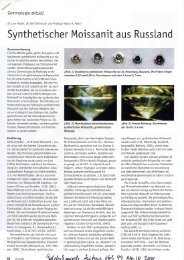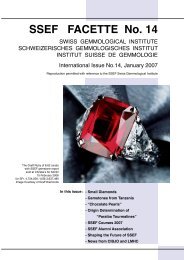SSEF FACETTE No. 17
SSEF FACETTE No. 17
SSEF FACETTE No. 17
You also want an ePaper? Increase the reach of your titles
YUMPU automatically turns print PDFs into web optimized ePapers that Google loves.
Fig. 2: Corrosion on a diamond surface during soldering<br />
repair when no borax was put on the stones.<br />
© H.A. Hänni, <strong>SSEF</strong>.<br />
soldering. A burned diamond surface when borax<br />
has not been used has also often be observed.<br />
Soldering can cause heat stress and even fracture<br />
to some set stones. A particularly intriguing example<br />
was observed in the form of a crater-shaped chip<br />
from a large diamond. The damage was caused by<br />
the impact of a soldering laser shot during a repair<br />
to a prong.<br />
Other examples of damage have included the<br />
removal of the polymer filler in B-Jade in an ultrasonic<br />
cleaner and serious etching to peridot from<br />
acid cleaning of jewellery in workshops, for example<br />
after soldering.<br />
When the author witnessed how easy it is to chip<br />
smoky quartz during setting, he turned his attention<br />
to the limited durability of gemstones. In 1988 he<br />
co-authored an educational booklet for goldsmith<br />
apprentices that included possible damage in the<br />
workshop (Schaffner & Hänni, 1988). Since he has<br />
been working in the <strong>SSEF</strong> gemmological laboratory<br />
he has encountered numerous gemstones with old<br />
or recent damage, always with client’s explanation<br />
of the possible reason, sometimes related to a case<br />
from an insurance company. The first systematic<br />
treatment of the subject of damage (Martin, 1987)<br />
was a timely contribution towards a better understanding<br />
of the different situations where damage<br />
can occur.<br />
Coincidentally a paper was published on damage to<br />
cut diamonds when it became clear that a diamond<br />
might not be forever (Hänni & Bosshart, 1987).<br />
Trigger observations were important in calculating<br />
the amount of systematically generated damage<br />
by diamond cutting factories in the cutting process.<br />
Fractures in emeralds with emanation polishing<br />
marks indicated that the damage was older than the<br />
buyer of an emerald ring could expect.<br />
A full report, including a discussion of some of the<br />
cases encountered over the last 29 years, has been<br />
published by Prof. Hänni, in English and in German.<br />
(see list of publications, page 24)<br />
<strong>SSEF</strong> Facette <strong>No</strong>. <strong>17</strong>, © 2010<br />
Gemmology<br />
CVD synthetic diamonds:<br />
<strong>No</strong>menclature, Production and Applications<br />
Will synthetic diamonds challenge natural diamonds<br />
in the future in the jewellery and watch markets?<br />
Since there is an ongoing debate between synthetic<br />
diamond producers and the CIBJO - The World<br />
Jewellery Confederation and IDC – International<br />
Diamond Council, let’s have a look at the current<br />
situation.<br />
<strong>No</strong>menclature<br />
Synthetic diamonds possess similar physical and<br />
chemical properties to natural diamonds. They show<br />
the same hardness, the same brilliancy, and the<br />
same thermal conductivity.<br />
Today some people would like them to rival natural<br />
diamond’s status. In doing so, they forget that in<br />
contrast to synthetic diamonds grown quickly in industrial<br />
apparatus, natural diamonds crystallised in<br />
the mantle of the earth at great depth – 120 km, and<br />
some of them are four billion years old. In relation<br />
to diamonds, the appearance of mankind on Earth<br />
happened almost yesterday, a mere 4 million years<br />
ago.<br />
When CIBJO recommends that the trade to use the<br />
term ‘synthetic’ to describe a synthetic diamond, it is<br />
simply to remind us that a synthetic diamond is not<br />
a natural diamond (see CIBJO box). The International<br />
Mineralogical Association (IMA) classified<br />
synthetic minerals in the category of anthropogenetic<br />
materials (made by man).<br />
Fig. 1: Microwave reactor of the “Laboratoire d’Inginiérie<br />
des Matériaux à Haute Pression”, Paris. The gas plasma<br />
appears white behind a thick quartz window.<br />
Photo © J.P. Chalain, <strong>SSEF</strong><br />
Chemical Vapour Deposition CVD<br />
The first CVD synthetic diamonds produced in the<br />
1950s consisted of polycrystalline layers on a metallic<br />
substrate. In the beginning, they were small and<br />
page 7









